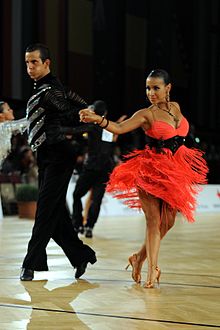Cha-cha-cha

Cha-cha-cha is the name of a Latin American music and dance, of Cuban origin.[1][2] It is dance music introduced by Cuban composer and violinist Enrique Jorrín in 1953. The rhythm was developed from a previous dance, the danzón, by a split fourth beat. The name is derived from the shuffling of the dancers' feet.[3]
Music
[change | change source]Many consider the Orquesta Aragón and the orchestra of José Fajardo to have been particularly influential in the development of the cha-cha-cha.[4] Outside Cuba, the big bands of Tito Puente (in New York), and Pérez Prado (in Mexico City and California) introduced the Cha-cha-cha to a much wider audience.
Dance
[change | change source]Musically, the Cha-cha-cha was perhaps not a great innovation. However, it became hugely popular because people found it easy to dance to. Monsieur Pierre and his colleagues went to Cuba in the early 1950s to study it. They came back to London and codified the dance (sorted it out and wrote it down). It became a standard dance in Latin American ballroom dancing.[5][6] It is one of the five Latin dances in international competitions governed by the World Dance Council. Today it is still popular as a dance, and is still danced in Cuba.
Other web-sites
[change | change source]- Former Latin World Champions Bryan Watson and Karen Hardy give a demo. [1]
References
[change | change source]- ↑ Orovio, Helio 2004. Cuban music from A to Z. p50
- ↑ Giro, Radamés 2007. Diccionario enciclopédico de la música en Cuba. La Habana. p281
- ↑ Jorrín, Enrique 1971. Origen del chachachá. Signos 3, 49.
- ↑ Santos, John. 1982. The Cuban Danzón (liner notes). New York, Folkways Records FE 4066
- ↑ Imperial Society of Teachers of Dancing 2004. 100 years of dance: a history of the ISTD Examinations Board. London. p62
- ↑ Lavelle, Doris 1983. Latin & American dances. 3rd ed, Black, London.
| |
| Participation | |
| Social | |
| Major present-day genres | |
| Technique |
|
| Regional (National dances) |
|
| Related |
|
Text is available under the CC BY-SA 4.0 license; additional terms may apply.
Images, videos and audio are available under their respective licenses.
